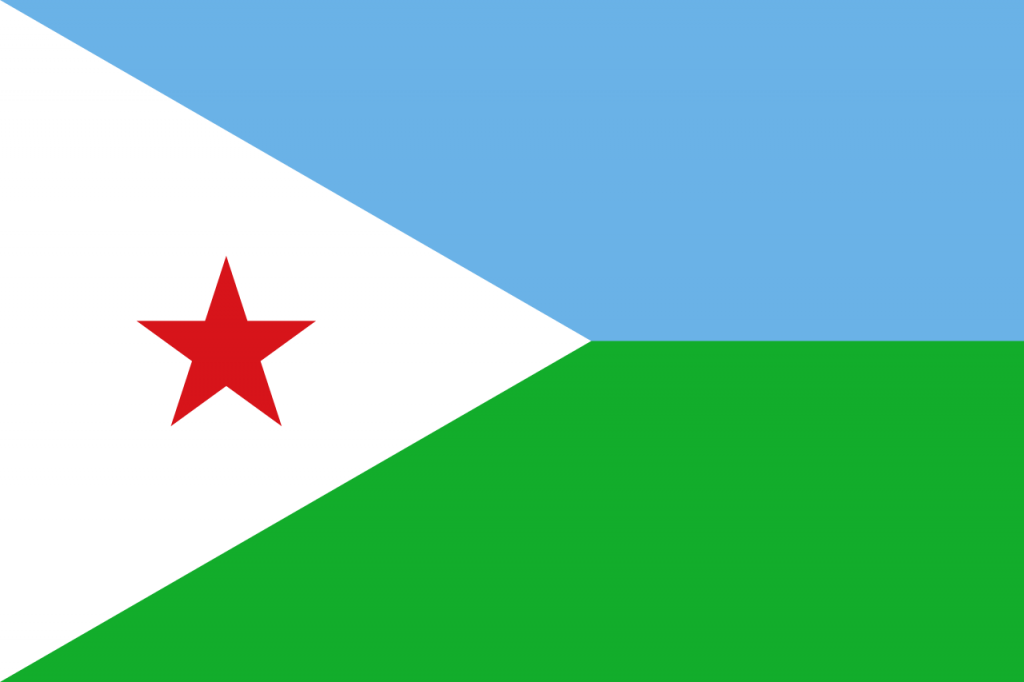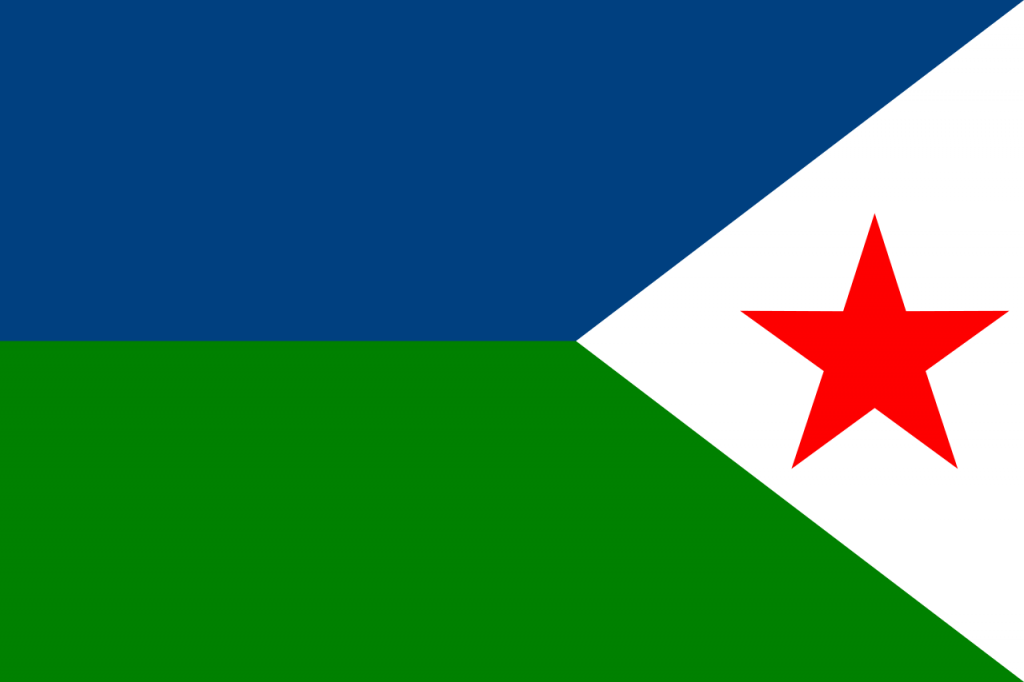One of the smallest and least known about nations in Africa, Djibouti sits comfortably at the horn of Africa between Somalia, Ethiopia and Eritrea. A good way for us to learn a little is to take a look at the flag of Djibouti and through that, we can learn about its history as a nation.
Flag of Djibouti

As you can see, the flag of Djibouti has four main elements. A blue stripe, a green stripe, a white triangle cutting between the two and a red star in the middle. Let’s kick things off with the colours, as they always tend to mean something symbolic in a national flag. The green represents the earth, while the blue represents the sky and sea. Pretty simple. But there’s another element. The blue represents the Somali people (as you can see on their national flag) while the green represents the Afars, another ethnic group in the region. Meanwhile, the white represents peace, naturally.
But what about the star, huh? Well, the star itself represents unity, the five points represent Djibouti being one of the five regions of the Somali people while the red is representative of the blood shed in the cause of Djibouti national liberation. You see Djibouti had to fight for its independence from French colonization. The instrument of achieving liberation was the Front for the Liberation of the Somali Coast. (FLCS is its French acronym, which I’ll use going forward.)
The FLCS was formed in 1960, following the independence of Somalia that year and a failed referendum in 1958 for the independence of Djibouti. The vote failed as a mix of significant Afar and French colonist support for continued French rule, coupled with heavy allegations of vote-rigging. The disenfranchised Somalis of Djibouti felt the need for a political formation to push for their goals, thus the creation of the FLCS.
Initially the FLCS mainly pushed their cause politically, leading protests and occasionally riots against the colonial authorities. In August of 1966, following French rejection of a UN recommendation that France grant the colony independence and a subsequent visit by French president Charles de Gaulle, riots between police and nationalists led to ten dead civilians and one dead French policeman. In response, the French authorities built a barbed wire barrier surrounding the entirety of Djibouti City, intended to prevent rebels from crossing the border from Somalia.
Of course a lot of these rebels were crossing from Somalia because France regularly deported ethnic Somali Djibouti nationals to Somalia as a means of controlling the opposition. With a population then of only a little over a hundred thousand, over 6,000 ethnic Somalis were deported between August 1966 and March 1967. A big reason for this is likely to be the 1967 referendum on independence, a referendum that was once again marred by allegations of vote-rigging, with 14,000 of Djibouti’s 58,000 Somalis recorded as having voted.
Militant Turn of the FLCS

You might notice the flag of the FLCS is basically the flag of Djibouti, just with a different shade of blue and flipped on its side. Maybe this is a spoiler, but the FLCS eventually won their campaign, though not without escalating the violence by quite a bit first. The flag of Djibouti would still take a while longer before it flew proudly over the nation.
The FLCS soon began actively attacking French colonial authorities, crossing from Somalia in many instances to fight the French military. Occasionally they would bomb targets and in other cases, such as in March of 1975, the FLCS kidnapped the French ambassador to Somalia to hold for ransom in exchange for FLCS activists held in French prisons. The FLCS was recognized as a national liberation movement by the Organization of African Unity, who began financing some of their activities. French control of Djibouti was becoming increasingly tenuous. The flag of Djibouti craved a change.
It was this year, 1975, that the FLCS also switched its demands from unification with Somalia to simple national independence. This was a more palatable prospect to groups like the Afars, who mainly feared their marginalization in a greater Somalian state. With this shift, the French had much less room to hide. The Afars didn’t like their colonial masters much more than the Somalis, nor did they like the ugly barbed wire fence enveloping their capital. When elections were set for 1977, the end was in sight.
Elections were held simultaneously with a referendum of independence on the 8th of May 1977. The FLCS backed People’s Rally for Independence won 65 of 65 available seats and the margin for support for independence shot up to 99%. These were numbers that even the colonial juggernaut’s of Europe couldn’t simply ignore. On the 27th of June, Djibouti gained its independence and the flag of Djibouti was finally permitted to fly over the capital. In addition, the FLCS militants were incorporated into the new national armed forces, to replace the French colonial army.
And that sums up the history and flag of Djibouti really! A nation only first formed in the 1970s, with a national identity that only gained an appetite for independence over incorporation with Somalia in the same decade, there’s no long list of previous flags that weren’t just those of former colonial masters. There’s only one flag of Djibouti and it stands for all those who live there.
If you’ve found yourself interested in the history of Djibouti, you might also be interested in visiting some day. Thankfully YPT have you covered there! You can check out some of the tours to Djibouti that we offer right here!





